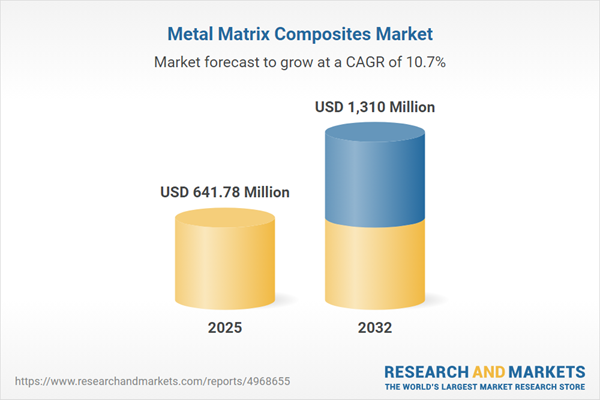Speak directly to the analyst to clarify any post sales queries you may have.
Metal matrix composites (MMCs) are reshaping strategic operations for global organizations seeking to enhance agility, manage risk, and maintain compliance in rapidly evolving industrial environments. Senior decision-makers are increasingly leveraging MMCs to drive innovation, reinforce supply chain robustness, and streamline pathways for regulatory adherence.
Market Snapshot: Metal Matrix Composites Market Size and Growth
The global metal matrix composites market achieved a value of USD 582.69 million in 2024, and is projected to reach USD 641.78 million by 2025 with expectations of surpassing USD 1.31 billion by 2032, reflecting a strong CAGR of 10.66%. This upward trend emphasizes a broader industrial shift towards lightweight, high-performance materials as key enablers of improved efficiency and risk reduction. Organizations are realigning investment priorities around MMCs to reinforce reliability, facilitate technology integration, and address increasingly stringent compliance requirements. As a result, sector-wide adoption of MMCs signals coordinated efforts to meet evolving operational and regulatory expectations while supporting immediate responsiveness and sustained competitiveness.
Scope & Segmentation: Comprehensive Value Chain Overview
- Matrix Metal Types: Includes aluminum, copper, magnesium, nickel, and titanium, selected for industry-specific attributes such as thermal management, corrosion resistance, and suitability for high-reliability applications.
- Reinforcement Types: Encompasses long and short fibers, particulates (boron carbide, silicon carbide), and hybrid structures, enhancing mechanical properties and thermal stability to meet operational demands.
- Processing Methods: Covers pressure infiltration, spray deposition, squeeze casting, stir casting, diffusion bonding, and powder blending, supporting both molten and solid-state MMC production for scale and cost-effectiveness.
- Applications: Deployed across brake components, aerospace structures, engine assemblies, and advanced thermal management systems to fulfill sector-specific requirements for reliability and lifespan extension.
- End-Use Industries: Adopted by automotive, aerospace, defense, industrial machinery, electronics, energy, and healthcare industries for quality assurance, modernization efforts, and production optimization.
- Geographical Regions: Adoption is notable across the Americas, Europe, Middle East, Africa, and Asia-Pacific. China, India, Japan, Australia, and South Korea are recognized as leading growth centers, while Southeast Asia broadens its posture in innovation.
- Key Companies: Market progress is driven by CPS Technologies Corporation, CeramTec GmbH, 3M Company, 3A Composites, APR Composites, Coherent Corp., and DWA Aluminum Composites USA, each investing in supply network expansion and integrated deployment strategies.
Key Takeaways: Strategic Insights for Senior Leadership
- MMCs prolong asset longevity and facilitate proactive maintenance models, ensuring operational stability as sector compliance standards shift.
- Advancements in additive manufacturing and automation have streamlined design customization, expedited part production, and accelerated technology transitions, enabling more agile implementation across high-demand industries.
- Focus on sustainable options, such as bio-based and recyclable composites, equips organizations to anticipate shifts in environmental requirements and stay ahead of regulatory changes.
- Building robust local vendor relationships and diversified supply networks supports greater resilience in the face of disruptions, logistical constraints, and evolving policies.
- Collaboration among original equipment manufacturers, research bodies, and suppliers ensures seamless MMC integration to satisfy complex operational and end-user demands.
Tariff Impact: Navigating U.S. Policy Changes
Adjustments to U.S. base metal tariffs have prompted companies dependent on metal matrix composites to reassess their procurement and manufacturing strategies. Senior leaders now prioritize domestic sourcing, cultivate resilient supplier partnerships, and adapt procurement frameworks to guarantee supply continuity. Transparent communications and flexible purchasing models are essential for maintaining operational certainty amid policy variability.
Methodology & Data Sources
Research insights are underpinned by direct interviews with industry executives, feedback from sector specialists, and a review of peer-reviewed literature and patent filings. This blended methodology delivers actionable direction for investment planning and resource deployment in the MMC space.
Why This Report Matters
- Empowers leadership to build investment roadmaps that prioritize responsible sourcing and supply chain stability even during market and regulatory shifts.
- Provides structured frameworks for benchmarking operational excellence, fostering continuous improvement and alignment with recognized industry standards.
- Enables organizations to scale operations strategically and navigate transitions in technology or compliance with clarity and confidence.
Conclusion
Metal matrix composites are emerging as a key driver for business resilience and supply chain efficiency. Strategic adoption positions organizations to capitalize on evolving market demands and fortify operational capabilities in complex industrial settings.
Additional Product Information:
- Purchase of this report includes 1 year online access with quarterly updates.
- This report can be updated on request. Please contact our Customer Experience team using the Ask a Question widget on our website.
Table of Contents
3. Executive Summary
4. Market Overview
7. Cumulative Impact of Artificial Intelligence 2025
Companies Mentioned
The companies profiled in this Metal Matrix Composites market report include:- CPS Technologies Corporation
- CeramTec GmbH
- 3M Company
- 3A Composites
- APR Composites
- Coherent Corp.
- DWA Aluminum Composites USA, Inc.
- GKN Powder Metallurgy Holding GmbH
- Goodfellow Cambridge Ltd.
- H.C. Starck GmbH
- Hitachi Metals, Ltd.
- KTW Technology GmbH
- Kyocera Corporation
- Materion Corporation
- Mitsubishi Materials Corporation
- OC Oerlikon Management AG
- Plansee SE
- Sandvik AB
- Sitek Insulation Sasu
- Thermo Fisher Scientific Inc.
Table Information
| Report Attribute | Details |
|---|---|
| No. of Pages | 184 |
| Published | November 2025 |
| Forecast Period | 2025 - 2032 |
| Estimated Market Value ( USD | $ 641.78 Million |
| Forecasted Market Value ( USD | $ 1310 Million |
| Compound Annual Growth Rate | 10.6% |
| Regions Covered | Global |
| No. of Companies Mentioned | 21 |









